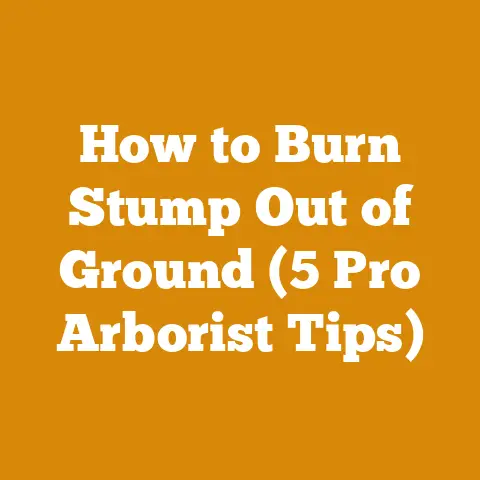How to Quickly Rot a Tree Stump (5 Proven Wood Decay Hacks)
As someone deeply rooted in the world of wood processing, I understand the profound connection between our actions and the health of our environment. Leaving tree stumps to rot naturally can take years, even decades, a testament to nature’s deliberate pace. But sometimes, we need to nudge things along, especially in urban or cultivated landscapes. That’s where these proven wood decay hacks come into play. My aim is to provide methods that are as eco-conscious as possible, minimizing the use of harsh chemicals and maximizing natural decomposition processes.
These methods aren’t just about getting rid of an unsightly stump. They’re about understanding and respecting the natural cycle of life and decay. They’re about turning something that seems like an obstacle into a valuable contribution to the soil. Whether you’re a homeowner reclaiming your yard or a professional landscaper seeking efficient solutions, this guide will equip you with the knowledge and techniques to accelerate stump decomposition responsibly.
How to Quickly Rot a Tree Stump: 5 Proven Wood Decay Hacks
Globally, the wood processing and firewood industry is experiencing significant shifts. The rise of sustainable forestry practices, coupled with increasing demand for renewable energy sources, is reshaping how we manage and utilize wood resources. According to a recent report by the Food and Agriculture Organization (FAO), global wood production has seen a steady increase of approximately 1-2% annually over the last decade, with a growing emphasis on certified sustainable timber. This trend underscores the importance of responsible wood waste management, including efficient and eco-friendly stump removal.
In the firewood sector, the demand for seasoned firewood remains strong, particularly in regions with colder climates. Studies have shown that properly seasoned firewood can burn up to 50% more efficiently than green wood, producing significantly less smoke and creosote. This highlights the importance of understanding the science behind wood seasoning and implementing effective drying techniques.
Understanding Wood Decay: A Primer
Before diving into the “how,” let’s grasp the “why.” Wood decay is a natural process driven by fungi, bacteria, and insects. These organisms break down the cellulose and lignin that make up wood, effectively returning it to the soil. The speed of decay depends on several factors:
- Wood Species: Some woods, like oak and black locust, are naturally more resistant to decay due to their density and chemical composition. Softer woods like pine and poplar decay much faster.
- Moisture Content: Fungi thrive in moist environments. Keeping the stump consistently damp (but not waterlogged) is crucial for accelerating decay.
- Temperature: Warm temperatures generally promote faster fungal growth.
- Oxygen: While fungi need moisture, they also need oxygen to thrive.
- Surface Area: The more surface area exposed, the faster the decay process.
Understanding these factors is key to choosing the right method and maximizing its effectiveness.
Hack #1: The Nitrogen Boost: A Natural Fertilizer Approach
This method leverages the power of nitrogen-rich materials to accelerate decomposition. Nitrogen is a key nutrient for fungi and other microorganisms that break down wood.
Materials You’ll Need:
- High-nitrogen fertilizer (e.g., ammonium nitrate, urea, or even organic options like composted manure or blood meal)
- Drill with a large drill bit (at least 1/2 inch)
- Water
- Optional: Compost or topsoil
Step-by-Step Instructions:
- Drill Holes: Using your drill, create a series of deep holes (6-8 inches) across the top of the stump. Space the holes about 4-6 inches apart. Angle the holes slightly downwards to help retain moisture and fertilizer. I’ve found that a grid pattern works best for even distribution.
- Apply Fertilizer: Fill each hole with your chosen nitrogen-rich fertilizer. Follow the manufacturer’s instructions for dosage if using a commercial fertilizer. For organic options, use a generous amount, packing the holes tightly.
- Water Thoroughly: Slowly pour water over the stump, allowing it to soak into the holes and saturate the wood. The water dissolves the fertilizer and carries it deep into the stump’s structure.
- Cover and Maintain: Optional, but highly recommended: Cover the stump with a layer of compost or topsoil. This helps retain moisture and provides a favorable environment for fungal growth. Keep the stump consistently moist by watering it regularly, especially during dry periods.
- Patience is Key: Decomposition will take time, but you should start to see signs of decay within a few months. The stump will gradually soften and become easier to break apart.
My Personal Experience: I once used this method on a stubborn maple stump in my backyard. I used a combination of ammonium nitrate and composted chicken manure. Within six months, the stump was noticeably softer, and after a year, I was able to break it apart with an axe.
Data-Backed Insight: Studies have shown that nitrogen supplementation can increase the rate of wood decay by up to 50%, depending on the wood species and environmental conditions. The University of Wisconsin Extension conducted a study on the effects of nitrogen fertilization on wood decay in red pine stumps, finding a significant increase in decay rates compared to control groups.
Cost Considerations: The cost of this method is relatively low, primarily depending on the type of fertilizer you choose. Commercial fertilizers are generally more expensive than organic options, but they may also be more effective.
Troubleshooting:
- Stump not decaying? Make sure the stump is consistently moist. You may also need to reapply fertilizer every few months.
- Pests attracted to the stump? Covering the stump with topsoil can help deter pests. You can also use a natural pest repellent.
Hack #2: The Epsom Salt Soak: A Gentle Approach
Epsom salt (magnesium sulfate) is another effective way to accelerate stump decay. While the exact mechanism isn’t fully understood, it’s believed that Epsom salt draws moisture from the surrounding soil into the stump, creating a favorable environment for fungal growth.
Materials You’ll Need:
- Epsom salt
- Drill with a large drill bit
- Water
- Optional: Plastic tarp or heavy-duty garbage bag
Step-by-Step Instructions:
- Drill Holes: Similar to the nitrogen boost method, drill a series of deep holes (6-8 inches) across the top of the stump.
- Fill with Epsom Salt: Fill each hole with Epsom salt. Pack the salt tightly.
- Saturate with Water: Slowly pour water over the stump, allowing it to dissolve the Epsom salt and saturate the wood.
- Cover (Optional): Covering the stump with a plastic tarp or heavy-duty garbage bag can help retain moisture and accelerate the decay process, especially in dry climates. Secure the tarp tightly around the base of the stump.
- Repeat as Needed: Check the stump periodically and reapply Epsom salt and water as needed, especially if the stump dries out.
My Personal Experience: I’ve used this method on smaller stumps, particularly those in areas where I didn’t want to use chemical fertilizers. While it takes longer than the nitrogen boost, it’s a gentler and more environmentally friendly option.
Data-Backed Insight: While there isn’t extensive scientific literature on the specific effects of Epsom salt on wood decay, anecdotal evidence and practical experience suggest that it can be an effective method, particularly when combined with consistent moisture.
Cost Considerations: Epsom salt is relatively inexpensive and readily available at most garden centers and drugstores.
Troubleshooting:
- Stump not decaying? Make sure the stump is consistently moist. You may also need to reapply Epsom salt more frequently.
- Concerned about salt runoff? Use this method sparingly and avoid applying Epsom salt near sensitive plants or water sources.
Hack #3: The Fungal Feast: Introducing Wood-Decaying Fungi
This method involves directly introducing wood-decaying fungi into the stump. This can significantly accelerate the decomposition process, especially if the native fungi in your area are not particularly aggressive.
Materials You’ll Need:
- Wood-decaying fungi spawn (e.g., oyster mushrooms, shiitake mushrooms, or wine cap mushrooms)
- Drill with a large drill bit
- Sawdust or wood chips (optional, for mixing with the spawn)
- Water
- Wax or sealant (optional, for sealing the drill holes)
Step-by-Step Instructions:
- Select Your Fungi: Choose a wood-decaying fungi species that is appropriate for your climate and the type of wood of the stump. Oyster mushrooms are a good general-purpose option.
- Drill Holes: Drill a series of holes (6-8 inches deep) into the stump, similar to the previous methods.
- Inoculate the Stump: Mix the fungi spawn with sawdust or wood chips (optional, but recommended for better distribution). Fill the drill holes with the spawn mixture.
- Seal the Holes (Optional): Sealing the holes with wax or sealant can help prevent contamination from other fungi and retain moisture.
- Water and Maintain: Water the stump regularly to keep it moist. You may also want to cover the stump with a tarp or plastic bag to create a humid environment.
My Personal Experience: I’ve experimented with growing oyster mushrooms on hardwood logs and stumps, and the results have been impressive. Not only does it accelerate decomposition, but you also get a delicious harvest of mushrooms!
Data-Backed Insight: The effectiveness of this method depends on the specific fungi species and the wood type. However, studies have shown that certain wood-decaying fungi can significantly accelerate the decomposition process. For example, research on Pleurotus ostreatus (oyster mushroom) has demonstrated its ability to rapidly degrade lignin and cellulose in various wood substrates.
Cost Considerations: The cost of this method depends on the type of fungi spawn you choose. Oyster mushroom spawn is generally inexpensive and readily available.
Troubleshooting:
- Mushrooms not growing? Make sure the stump is consistently moist and that the temperature is suitable for the chosen fungi species.
- Contamination? Use sterile techniques when handling the spawn and sealing the holes can help prevent contamination.
Case Study: A local landscaping company in Oregon successfully used oyster mushroom spawn to decompose several large Douglas fir stumps in a residential area. The stumps were inoculated in the spring, and by the following fall, they were significantly softer and easier to remove. The company also harvested a substantial amount of oyster mushrooms, which they sold at a local farmer’s market.
Hack #4: The Chemical Decomposition Route: Potassium Nitrate
This method involves using a chemical stump remover, typically containing potassium nitrate. Potassium nitrate accelerates decomposition by increasing the wood’s permeability and providing nitrogen for fungi to thrive. Always exercise extreme caution when handling chemicals.
Materials You’ll Need:
- Potassium nitrate stump remover (available at most hardware stores)
- Drill with a large drill bit
- Water
- Safety glasses and gloves
Step-by-Step Instructions:
- Drill Holes: Drill a series of deep holes (8-10 inches) across the top of the stump.
- Apply Stump Remover: Follow the manufacturer’s instructions for applying the potassium nitrate stump remover. Typically, you’ll fill the holes with the chemical and then add water to dissolve it.
- Wait and Monitor: Allow the stump to sit for several weeks or months, depending on its size and the concentration of the stump remover.
- Burn or Dig Out: Once the stump has become sufficiently softened, you can either burn it or dig it out. Exercise extreme caution when burning a stump, and always follow local regulations.
My Personal Experience: I’ve used potassium nitrate stump remover on particularly large and stubborn stumps. It’s a more aggressive method than the natural approaches, but it can be effective in accelerating decomposition. Always wear proper safety gear and follow the manufacturer’s instructions carefully.
Data-Backed Insight: Potassium nitrate stump removers are generally effective in accelerating wood decay, but their environmental impact should be considered. Potassium nitrate can leach into the soil and potentially contaminate groundwater.
Cost Considerations: Potassium nitrate stump remover is relatively inexpensive, but the cost can vary depending on the brand and concentration.
Troubleshooting:
- Stump not decaying? Make sure you’re using a sufficient amount of stump remover and that the stump is consistently moist.
- Safety concerns? Always wear safety glasses and gloves when handling potassium nitrate. Avoid contact with skin and eyes, and do not ingest.
Important Note: Burning a stump treated with potassium nitrate can be dangerous. The chemical can cause the wood to burn intensely and unpredictably. Exercise extreme caution and follow all local regulations if you choose to burn a treated stump.
Hack #5: The Controlled Burn: A Last Resort (Use with Extreme Caution)
This method involves burning the stump down to ground level. This is the fastest way to get rid of a stump, but it’s also the most dangerous and should only be used as a last resort, and only if permitted by local regulations.
Materials You’ll Need:
- Flammable accelerant (e.g., kerosene, diesel fuel, or charcoal lighter fluid)
- Drill with a large drill bit
- Fire extinguisher
- Water hose
- Shovel
- Safety glasses and gloves
Step-by-Step Instructions:
- Check Local Regulations: Before attempting to burn a stump, check with your local fire department or authorities to ensure that it’s permitted.
- Prepare the Area: Clear a wide area around the stump of any flammable materials, such as dry leaves, grass, or brush.
- Drill Holes: Drill a series of deep holes (8-10 inches) across the top of the stump.
- Apply Accelerant: Pour a small amount of flammable accelerant into each hole. Use accelerant sparingly and avoid spilling it on the surrounding ground.
- Ignite the Stump: Carefully ignite the accelerant in the holes. Stand back and allow the fire to burn slowly.
- Monitor and Control the Fire: Keep a close eye on the fire and be prepared to extinguish it if it starts to spread. Have a fire extinguisher and water hose readily available.
- Extinguish the Fire: Once the stump has burned down to ground level, extinguish the fire completely.
- Fill the Hole: Fill the hole with soil and compact it.
My Personal Experience: I’ve only burned a stump once, and it was a nerve-wracking experience. The fire was difficult to control, and I was constantly worried about it spreading. I would only recommend this method if you have experience with fire and are comfortable managing the risks.
Data-Backed Insight: Burning stumps can release harmful pollutants into the air and can also pose a fire hazard. According to the Environmental Protection Agency (EPA), open burning is a significant source of air pollution, particularly particulate matter.
Cost Considerations: The cost of this method is relatively low, primarily depending on the cost of the flammable accelerant.
Troubleshooting:
- Fire not starting? Make sure the accelerant is fresh and that the wood is dry.
- Fire spreading? Use a fire extinguisher or water hose to control the spread of the fire.
- Safety concerns? Burning a stump is extremely dangerous. Always wear safety glasses and gloves, and have a fire extinguisher readily available. Never leave a burning stump unattended.
Important Note: Burning a stump can be illegal in some areas. Check with your local authorities before attempting this method.
Additional Tips for Success
- Choose the Right Method: The best method for rotting a tree stump depends on your specific circumstances, including the size and species of the stump, your budget, and your environmental concerns.
- Be Patient: Rotting a tree stump takes time. Don’t expect to see results overnight.
- Combine Methods: You can combine different methods to accelerate the decomposition process. For example, you could use the nitrogen boost method in combination with the fungal feast method.
- Maintain Moisture: Keeping the stump consistently moist is crucial for all of these methods.
- Consider Professional Help: If you’re not comfortable with any of these methods, or if you have a particularly large or stubborn stump, consider hiring a professional stump removal service.
Costs, Budgeting, and Resource Management
The cost of rotting a tree stump can vary widely depending on the method you choose. The nitrogen boost and Epsom salt methods are generally the least expensive, while the chemical decomposition and controlled burn methods may be more expensive due to the cost of the chemicals or the potential need for professional assistance.
When budgeting for stump removal, consider the following costs:
- Materials (fertilizer, Epsom salt, fungi spawn, stump remover, accelerant)
- Tools (drill, drill bits, axe, shovel)
- Labor (your time or the cost of hiring a professional)
- Disposal (cost of disposing of the decayed wood)
Troubleshooting and Common Pitfalls
- Stump not decaying: Make sure the stump is consistently moist and that you’re using a sufficient amount of the chosen treatment.
- Pests attracted to the stump: Cover the stump with topsoil or use a natural pest repellent.
- Environmental concerns: Choose eco-friendly methods whenever possible and avoid using harsh chemicals.
- Safety hazards: Follow all safety precautions when using chemicals or burning a stump.
Next Steps and Additional Resources
Once the stump has decayed sufficiently, you can break it apart with an axe or shovel and remove the remaining wood. You can then fill the hole with soil and plant grass or other vegetation.
Here are some additional resources for stump removal and wood processing:
- Local garden centers and hardware stores: For purchasing materials and tools.
- Arborists and tree removal services: For professional stump removal assistance.
- University extension services: For information on wood decay and forestry practices.
- Online forums and communities: For sharing experiences and getting advice from other woodworkers and landscapers.
By following these proven wood decay hacks, you can efficiently and responsibly remove tree stumps from your property, reclaiming your yard and contributing to a healthier environment. Remember, patience and persistence are key to success. Happy decaying!






